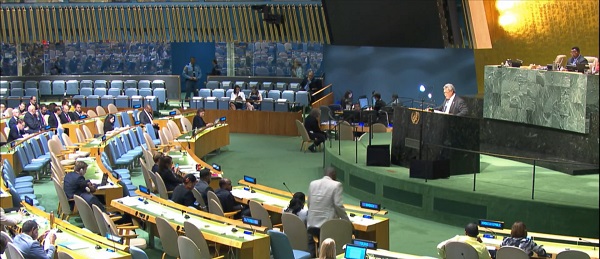Daily Caller
‘Landman’ Airs A Rare And Stirring Defense Of The U.S. Oil-And-Gas Industry

Actor Billy Bob Thornton portraying the character Tommy Norris in an official trailer for the Paramount Plus series “Landman.” (Screen Capture/Landman, Official Trailer, Paramount+)

From the Daily Caller News Foundation
By David Blackmon
Oil companies have always presented easy targets for demonization by the news and entertainment industries. Their operations are highly visible — the flares from a shale well can be seen from many miles distant — the prices they charge for their products can strain family budgets, and they have generally done a lousy job of engaging with the media and defending themselves.
Thus, they typically present the proverbial low-hanging fruit to be exploited by lazy script writers in Hollywood. Those who were in the industry in the early years of the Obama presidency will well remember that pretty much every TV drama series aired at least one episode centered on some highly improbable, often impossible, scenario in which people were killed by a hydraulic fracturing — or “fracking” — accident. Such stuff never happened in real life, but it sure made for compelling entertainment for audiences who did not know that to be the case.
Given this history, it came as no small surprise when the lead character in the new Paramount series “Landman”, the newest offering from “Yellowstone” creator Taylor Sheridan, delivered a stirring 2-minute monologue in defense of America’s oil and gas producers in Episode 3 of the show’s first season. Set in the aftermath of a tragic, fatal Permian Basin oilfield accident that actually could happen in real life, the scene features lead character Tommy Norris, played to near perfection by Billy Bob Thornton, schooling a young, environmentally conscious lawyer who is looking for someone to blame for the accident on the reasons why oil and gas are highly unlikely to be replaced by wind energy in her lifetime.
“You have any idea how much diesel they have to burn to mix that much concrete or make that steel and hold this **** out here and put it together with a 450-foot crane,” Norris says, pointing to a nearby group of 400 ft. wind turbines. “You want to guess how much oil it takes to lubricate that ****ing thing or winterize it? In its 20-year lifespan it won’t offset the carbon footprint of making it. And don’t get me started on solar panels and the lithium in your Tesla battery.”
The monologue goes on for another minute and a half, with Norris detailing all the myriad products made with oil and natural gas, and the fact that, “if Exxon thought them ****ing things right there were the future, they’d be putting them all over the ***damn place.” He isn’t wrong about that last part, by the way. ExxonMobil and its fellow major oil companies like Shell and BP have proven themselves to be pretty much agnostic about the nature of the energy-related projects they’re willing to pursue in recent years.
Those companies and many other traditional oil companies are willing to invest in most any project they believe to be profitable, sustainable and able to deliver strong rates of return to investors. Where wind energy is concerned, both Shell and BP spent years investing heavily in such projects but have been backing away from such investments over the last year as they have failed to produce adequate returns. ExxonMobil, meanwhile, is investing heavily in carbon capture, hydrogen, and even lithium production as part of a growing portfolio of projects in its Low Carbon Solutions business unit.
Back to the Tommy Norris monologue: When I re-posted the clip on LinkedIn and at my Substack newsletter, it went viral, indicating a high level of interest in what Thornton’s character had to say. That may be indicative of a rising recognition of the reality that the US government and global community have in recent years thrown away trillions of dollars in failing attempts to subsidize non-viable, unsustainable, and unprofitable alternatives to oil and natural gas to scale.
Perhaps, then, it is no coincidence that Episode 3 of “Landman” aired on the same day when the media widely reported the COP29 climate conference in Azerbaijan had ended in failure. It also came amid continuing reports that the Trump transition team is developing detailed plans to refocus US energy policy back to Trump’s promised “drill, baby, drill” orientation.
The times are a-changing, and guys like Tommy Norris will look like prophets soon.
David Blackmon is an energy writer and consultant based in Texas. He spent 40 years in the oil and gas business, where he specialized in public policy and communications.
Business
UN’s ‘Plastics Treaty’ Sports A Junk Science Wrapper


From the Daily Caller News Foundation
By Craig Rucker
According to a study in Science Advances, over 90% of ocean plastic comes from just 10 rivers, eight of which are in Asia. The United States, by contrast, contributes less than 1%. Yet Pew treats all nations as equally responsible, promoting one-size-fits-all policies that fail to address the real source of the issue.
Just as people were beginning to breathe a sigh of relief thanks to the Trump administration’s rollback of onerous climate policies, the United Nations is set to finalize a legally binding Global Plastics Treaty by the end of the year that will impose new regulations, and, ultimately higher costs, on one of the world’s most widely used products.
Plastics – derived from petroleum – are found in everything from water bottles, tea bags, and food packaging to syringes, IV tubes, prosthetics, and underground water pipes. In justifying the goal of its treaty to regulate “the entire life cycle of plastic – from upstream production to downstream waste,” the U.N. has put a bull’s eye on plastic waste. “An estimated 18 to 20 percent of global plastic waste ends up in the ocean,” the UN says.
As delegates from over 170 countries prepare for the final round of negotiations in Geneva next month, debate is intensifying over the future of plastic production, regulation, and innovation. With proposals ranging from sweeping bans on single-use plastics to caps on virgin plastic output, policymakers are increasingly citing the 2020 Pew Charitable Trusts report, Breaking the Plastic Wave, as one of the primary justifications.
But many of the dire warnings made in this report, if scrutinized, ring as hollow as an empty PET soda bottle. Indeed, a closer look reveals Pew’s report is less a roadmap to progress than a glossy piece of junk science propaganda—built on false assumptions and misguided solutions.
Pew’s core claim is dire: without urgent global action, plastic entering the oceans will triple by 2040. But this alarmist forecast glosses over a fundamental fact—plastic pollution is not a global problem in equal measure. According to a study in Science Advances, over 90% of ocean plastic comes from just 10 rivers, eight of which are in Asia. The United States, by contrast, contributes less than 1%. Yet Pew treats all nations as equally responsible, promoting one-size-fits-all policies that fail to address the real source of the issue.
This blind spot has serious consequences. Pew’s solutions—cutting plastic production, phasing out single-use items, and implementing rigid global regulations—miss the mark entirely. Banning straws in the U.S. or taxing packaging in Europe won’t stop waste from being dumped into rivers in countries with little or no waste infrastructure. Policies targeting Western consumption don’t solve the problem—they simply shift it or, worse, stifle useful innovation.
The real tragedy isn’t plastic itself, but the mismanagement of plastic waste—and the regulatory stranglehold that blocks better solutions. In many countries, recycling is a government-run monopoly with little incentive to innovate. Meanwhile, private-sector entrepreneurs working on advanced recycling, biodegradable materials, and AI-powered sorting systems face burdensome red tape and market distortion.
Pew pays lip service to innovation but ultimately favors centralized planning and control. That’s a mistake. Time and again, it’s been technology—not top-down mandates—that has delivered environmental breakthroughs.
What the world needs is not another top-down, bureaucratic report like Pew’s, but an open dialogue among experts, entrepreneurs, and the public where new ideas can flourish. Imagine small-scale pyrolysis units that convert waste into fuel in remote villages, or decentralized recycling centers that empower informal waste collectors. These ideas are already in development—but they’re being sidelined by policymakers fixated on bans and quotas.
Worse still, efforts to demonize plastic often ignore its benefits. Plastic is lightweight, durable, and often more environmentally efficient than alternatives like glass or aluminum. The problem isn’t the material—it’s how it has been managed after its use. That’s a “systems” failure, not a material flaw.
Breaking the Plastic Wave champions a top-down, bureaucratic vision that limits choice, discourages private innovation, and rewards entrenched interests under the guise of environmentalism. Many of the groups calling for bans are also lobbying for subsidies and regulatory frameworks that benefit their own agendas—while pushing out disruptive newcomers.
With the UN expected to finalize the treaty by early 2026, nations will have to face the question of ratification. Even if the Trump White House refuses to sign the treaty – which is likely – ordinary Americans could still feel the sting of this ill-advised scheme. Manufacturers of life-saving plastic medical devices, for example, are part of a network of global suppliers. Companies located in countries that ratify the treaty will have no choice but to pass the higher costs along, and Americans will not be spared.
Ultimately, the marketplace of ideas—not the offices of policy NGOs—will deliver the solutions we need. It’s time to break the wave of junk science—not ride it.
Craig Rucker is president of the Committee For A Constructive Tomorrow (www.CFACT.org).
Business
‘Experts’ Warned Free Markets Would Ruin Argentina — Looks Like They Were Dead Wrong


From the Daily Caller News Foundation
The current state of Argentina’s economy is a far cry from what “experts” predicted when they warned that President Javier Milei’s pro-free market leadership would devastate the country.
The chainsaw-wielding libertarian rose to power on promises to slash government spending, implement free-market policies and lift strict currency controls to rescue a nation crippled by inflation, debt and entrenched poverty. Though the pundit class warned that Milei’s policies would spark an economic collapse, the results so far have been a rebuke to those warnings.
Just days before the November 2023 presidential election, 108 economists from around the world signed an open letter claiming that Milei’s “simple solutions” were “likely to cause more devastation in the real world in the short run, while severely reducing policy space in the long run.”
“His policies are poorly thought through. Far from building a consensus, he would struggle to govern,” The Economist’s editorial board wrote in a September 2023 piece describing “Javier Milei’s dangerous allure.”
Well over a year into Milei’s presidency, Argentina is showing its strongest economic performance in years. The country’s gross domestic product (GDP) jumped 7.7% in April compared to the same month in 2024, far exceeding expectations.
The GDP is expected to rise by 5.2% in 2025, compared to declines of 1.3% in 2024 and 1.9% in 2023, according to the Organization for Economic Cooperation and Development (OECD).
Inflation, a long-standing hallmark of Argentina’s economic dysfunction, dropped to 1.5% between April and May, reaching a five-year low. Annual inflation has plunged from 160.9% in November 2023 — just before Milei took office — to 43.5% in May.
Meanwhile, poverty rates have also declined sharply, falling from 52.9% in the first half of 2024 to 38.1% in the second half of the year.
Argentina’s rental housing supply also increased by 212% between December 2023 and June 2024, after Milei repealed the country’s rent control laws, according to the Cato Institute.
“Against the background of a difficult legacy of macroeconomic imbalances, Argentina has embarked on an ambitious reform process, starting with an unprecedented upfront fiscal adjustment. Reforms have started to pay off. Inflation has receded and the economy is set for a strong recovery,” the OECD noted in its new analysis of the Argentinian economy. “Maintaining the reform momentum will be key to restore confidence, boost investment and productivity growth.”
Milei — a self-described anarcho-capitalist — has been an ardent supporter of President Donald Trump’s efforts to downsize the U.S. government, including the Department of Government Efficiency’s (DOGE) push to cut spending.
“I come from a country that bought all of those stupid ideas that went from being one of the most affluent countries in the world to one to one of the [poorest],” Milei said in a speech at the Conservative Political Action Conference in 2024. “If you don’t fight for your freedom, they will drag you into misery … Don’t surrender.”
-

 International2 days ago
International2 days agoSecret Service suspends six agents nearly a year after Trump assassination attempt
-

 Bruce Dowbiggin1 day ago
Bruce Dowbiggin1 day agoThe Covid 19 Disaster: When Do We Get The Apologies?
-

 Crime22 hours ago
Crime22 hours agoSweeping Boston Indictment Points to Vast Chinese Narco-Smuggling and Illegal Alien Labor Plot via Mexican Border
-

 Alberta1 day ago
Alberta1 day agoAlberta school boards required to meet new standards for school library materials with regard to sexual content
-

 Business2 days ago
Business2 days agoWEF-linked Linda Yaccarino to step down as CEO of X
-

 Automotive2 days ago
Automotive2 days agoAmerica’s EV Industry Must Now Compete On A Level Playing Field
-

 Environment22 hours ago
Environment22 hours agoEPA releases report on chemtrails, climate manipulation
-

 Business2 days ago
Business2 days ago‘Experts’ Warned Free Markets Would Ruin Argentina — Looks Like They Were Dead Wrong



